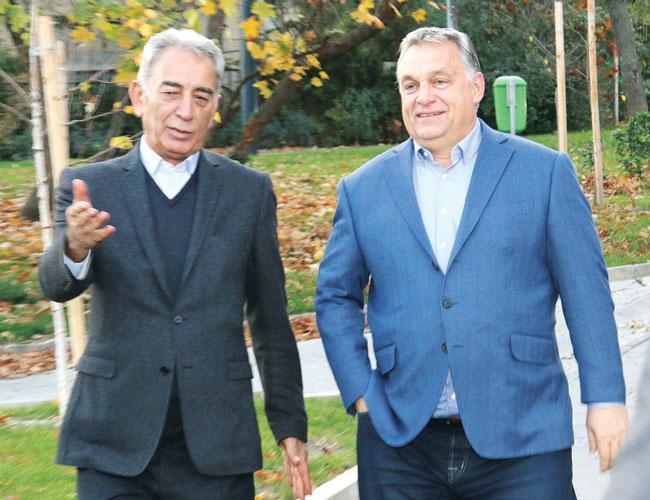
Hungarian Prime Minister Orban (R) and Turkish businessman Adnan Polat.
The Tomb of Gül Baba, which was opened last month after a joint renovation project of Turkey and Hungary, attracts visitors in the Hungarian capital Budapest. Thousands of tourists have visited the tomb and the rose gardens around it since the opening.
A symbol of Turkish and Hungarian relations, the Tomb of Gül Baba was restored with the initiative of Polat Holding Board Chair and Turkey-Hungary Business Council President Adnan Polat and opened to visitors on Oct. 9.
During a recent trip to the tomb, Turkish press members came together with Polat and Hungarian President Viktor Orban.
“We are in a very special place. Before its opening with the attendance of Turkish President Recep Tayyip Erdoğan a month ago, this place was neglected under very bad conditions. A few years ago, we spoke with Erdoğan about the restoration of this place. It is thought that it would be very easy to realize something when two leaders made a decision on it but it is not,” said Orban, stating that the Tomb of Gül Baba had a significant place both for Turks and Hungarians.
“The restoration was made within certain rules. Gül Baba is important not only for you but also for us. This place has become a source of pride both for Turks and Hungarians,” he said.
Polat said that when they came to Hungary 30 years ago to establish a logistics center, they visited the tomb.
“When we returned to Turkey, I told them about the situation to late President Süleyman Demirel. He made a request to the Culture and Tourism Ministry and the restoration process started. At that time, we made a symbolic opening when Demirel visited the tomb. Then I saw in the visitor book that this place was visited by Christians as much as Muslims. For example, on the night of the opening, nearly 200 Hungarian citizens came here and prayed for Gül Baba,” he said.
Book and TV series project
The council president said Gül Baba was respected by people of all religions, languages and races.
“He is a Bektashi dervish who was born in Merzifon. According to a rumor, he opened the Mekteb-i Sultani [Lycée Impérial Ottoman] at the time of Bayezid II and later on, this school became the Galatasaray High School. As the Galatasaray Football Club was founded because of this school, we see Gül Baba as a spiritual founder,” he said.
The businessman chaired Turkish club between 2008 and 2011.
Polat said the Turkish Cooperation and Coordination Agency (TİKA) worked hard during the restoration process.
 “Laws and regulations were not appropriate here and many changes were made. The Turkish side worked here for two years. On the Hungarian side, a state organization responsible for real estate worked here. It was finished in two years and the opening was made by Orban and Erdoğan,” he said.
“Laws and regulations were not appropriate here and many changes were made. The Turkish side worked here for two years. On the Hungarian side, a state organization responsible for real estate worked here. It was finished in two years and the opening was made by Orban and Erdoğan,” he said.
The tomb had attracted 3,000-4,000 visitors annually before the restoration but now the number of visitors exceeds 10,000, said the council president.
“Our organization system is new. We have lots of things to do. But our goal is to do our best to gain these artifacts from our ancestors with the contributions of Turkish and Hungarian states,” said Polat.
“Gül Baba has become a symbol. Besides being the spiritual founder of the Galatasaray Club, he has become the symbol of unity, solidarity, health and tolerance here. His tomb is even visited by European people. Most of the visitors of Gül Baba are Christians. There is one more place respected and visited by both Muslims and Christians, the Virgin Mary Church in İzmir’s Ephesus,” he said.
“Next year, we will get historians write a book on Gül Baba. We also plan to make a TV series on him just like Suleiman the Magnificent,” he said, adding that they had other plans for Gül Baba.
The Tomb of Gül Baba
A native of Merzifon in the Anatolian province of Amasya, Gül Baba was an Ottoman Bektashi dervish and companion of Sultan Suleiman the Magnificent. He died in 1541 in Buda, the western side of the Danube River in Budapest. His octagonal tomb was built between 1543 and 1548 in Rozsadomb (Rose Hill) on the Buda side of Budapest.
The structure, an Ottoman-era artifact in the most northern part of the Europe, has undergone many restorations throughout history. Within a protocol signed between Turkey and Hungary in 2015, the most comprehensive restoration project was initiated on Sept. 6, 2016 and finished in two years.
As part of the works, archaeological excavations were carried out and the tomb was renovated true to its original. It currently serves as the Tomb of Gül Baba and Cultural Center.
The current Gül Baba exhibition in the cultural center is organized under five thematic sections, including “Ottomans in Hungary,” “The World of Dervishes,” “Gül Baba,” “Gül Baba of Memories” and Gül Baba of Hungarians.”
The exhibition displays various Ottoman objects in Hungary as well as clothes and tools used by dervishes and archive documents.
In addition, the Hagia Sophia exhibition in the cultural center displays the important features of Istanbul’s Hagia Sophia Museum, one of the most visited museums in the world.